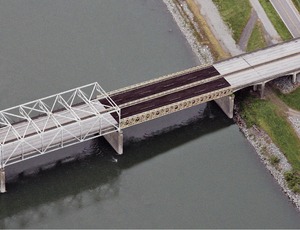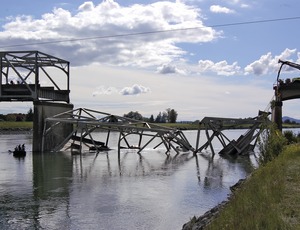

Fast-track construction methods will be used for both temporary and permanent fixes to restore Washington state's main north-south connector, from Seattle to Canada, after the May 23 collapse of an Interstate 5 bridge span into the Skagit River.
Washington State Dept. of Transportation officials took less than 72 hours to announce that a temporary structure will be in place by mid-June and a permanent replacement sometime in the fall—likely by the end of September—for a 160-ft-long section of a Warren-type through-truss bridge that took a hit from an oversized-load truck. The section crumpled into the shallow Skagit River, along with two vehicles, in northern Washington state, but no one was killed.
The truck, a permitted, wide-load vehicle, was traveling southbound from Alberta, Canada, in the right lane when a piece of its wide load hit the bridge. The steel crumpled, and the northernmost section, from the shore to the first concrete support, buckled into the river.
The remaining three sections of the 1,111-ft-long fracture-critical bridge—safety-rated at 57.4 on a 1-to-100 scale under the Federal Highway Administration system—were deemed safe, prompting WSDOT to hire Guy F. Atkinson Construction under an emergency contract to clear debris from the river.
Gov. Jay Inslee (D) has stated that plans will be out within weeks for a temporary fix on the route that carries 71,000 daily vehicles. The fix is expected to include a narrower four-lane bridge comprising two 24-ft-wide spans.
Atkinson will preconstruct the temporary steel-girder bridge at another location and truck it to the site to accelerate installation. "The plan minimizes the closure time," Inslee says.
Once the temporary span is in, crews will immediately start work on the permanent bridge by placing temporary piers in the river to support a platform, adjacent to the collapsed span, at the site where the new section will be built. Once complete, the temporary span will be removed and the new permanent span will slide into place, says Todd Harrison, acting WSDOT bridge engineer.
There could be another two-week closure in September to install the permanent span, Harrison says. While a permanent design is not finalized, it may be a steel-girder system that differs from the remaining three truss sections. Since concrete pylons independently support each span, there is no need for it to structurally match the rest of the bridge, says Travis Phelps, a WSDOT spokesman. State officials hope to set a time line for the bidding process for the permanent fix before June 1, he says.
Rep. Rick Larsen (D) confirmed that the U.S. Dept. of Transportation has emergency funds to pay for 100% of the temporary fix and 90% of the permanent replacement—a $15-million total bill. Already, $1 million has been released.
The National Transportation Safety Board (NTSB) is still picking through the debris of the bridge, which was built in 1955. NTSB Chairman Deborah A.P. Hersman says the truck's permit was good for a height of 15 ft, 9 in. While the center height of the bridge is 18 ft, the height at the white fog line is just 15 ft, 6 in. The shoulder drops to 14 ft, 6 in., at some points. Using 3D laser scans, crews are "reconstructing the before and after conditions of the bridge," Hersman says.


Post a comment to this article
Report Abusive Comment